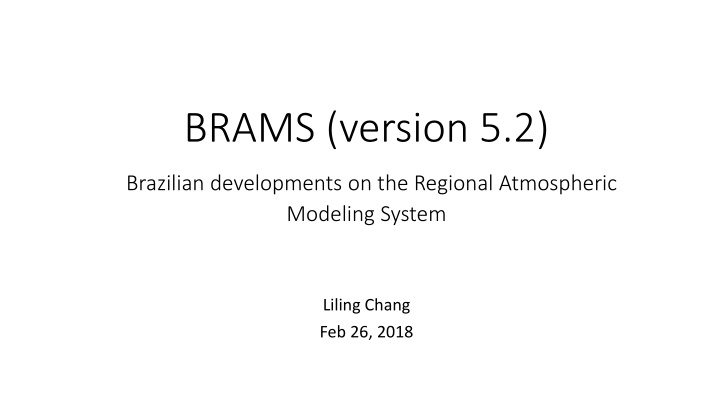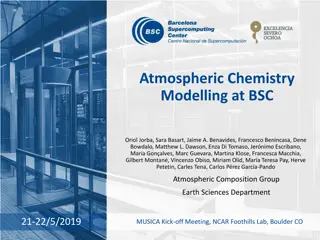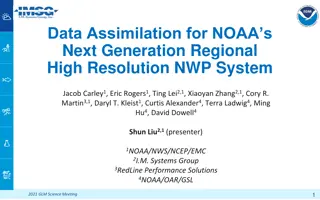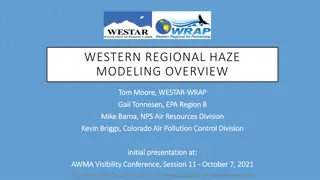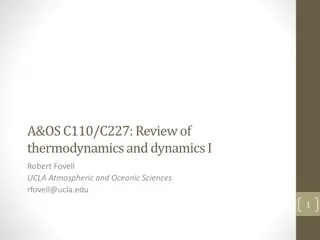BRAMS 5.2: Brazilian Regional Atmospheric Modeling System Overview
Developed from RAMS with improved tropical and sub-tropical representations, BRAMS 5.2 is a non-hydrostatic numerical weather prediction model that simulates atmospheric circulations from large eddies to planetary-scale waves. It utilizes compressible equations, conservation of mass and heat principles, along with water primitive equations for accurate modeling. The system incorporates advanced parameterizations for various atmospheric processes to enhance forecasting capabilities in different regions.
Download Presentation

Please find below an Image/Link to download the presentation.
The content on the website is provided AS IS for your information and personal use only. It may not be sold, licensed, or shared on other websites without obtaining consent from the author.If you encounter any issues during the download, it is possible that the publisher has removed the file from their server.
You are allowed to download the files provided on this website for personal or commercial use, subject to the condition that they are used lawfully. All files are the property of their respective owners.
The content on the website is provided AS IS for your information and personal use only. It may not be sold, licensed, or shared on other websites without obtaining consent from the author.
E N D
Presentation Transcript
BRAMS (version 5.2) Brazilian developments on the Regional Atmospheric Modeling System Liling Chang Feb 26, 2018
Overview BRAMS 5.2: developed from the Regional Atmospheric Modeling System (RAMS) with improved representations in tropical and subtropical regions Numerical weather prediction model: simulate atmospheric circulations from planetary-scale waves down to large eddies of the planetary boundary layer Non-hydrostatic, time-split, compressible equations Not anelastic: keep sound waves Equations are all Reynolds-averaged
Conservation of Mass Primitive equation ?? ?? = ??? ?? ??? ?? ??? ?? ?? ?? Scaled pressure: ? = (? ? ?,?,? = ?0(?) + ? (?,?,?) Fully compressible Acoustic adjustment: local pressure changes depend on local mass convergence Eliminate diabatic heating and pressure advection N???????? cs2= ?????0?0 ?0) ?? BRAMS equation: combining the ideal gas equation with the mass continuity equation for compressible fluids ?? ?? ??0 ???0?0 ??0?0? ?? +??0?0? +??0?0? = ?? ?? ?0= reference state for air density ?0= reference state for Exner function ? = perturbation Exner function ?0= reference state for potential temperature ??= specific heat of air at constant volume
Conservation of Heat Primitive equation ?? ??= ??? ?? ??? ?? ??? ??. + ?? Parameterization BRAMS equation ???? ??= ????? ?? ????? ?? ????? ? ??? ???? ?? ? ???? ?? ? ??? ???? ?? ???? ?? ???? ?? ???+ (???? ??+ + ??? + + ???+ ??)??? ??? ice liquid water potential temperature ? = eddy viscosity coefficient for heat and moisture con = subscript denoting tendency from convective parameterization rad = subscript denoting tendency from radiation parameterization mic = subscript denoting tendency from resolvable-scale microphysical parameterization
Conservation of Water Primitive equation ??? ??= ???? ?? ???? ?? ???? ??+ ??? Parameterization BRAMS equation ??? ??= ???? ?? ???? ?? ???? ? ??? ??? ?? ? ??? ?? ? ??? ??? ?? ??? ?? ???+ (??? + ??? + + ??)??? ??+ ?? = water mixing ratio species of total water, rain, pristine crystals, aggregates, and snow (water phases follow a prescribed gamma distribution) ? = eddy viscosity coefficient for heat and moisture con = subscript denoting tendency from convective parameterization mic = subscript denoting tendency from resolvable-scale microphysical parameterization
Conservation of Momentum Primitive equation for motion in x-direction: ? ?= ? ? ? ? ? ? ? ? ? ? 2 ? ??? + 2 ? ??? + ?? ? 1 ? ?? ?? Scaled pressure: ? = (? Eliminate products of perturbations: ? ?? ?0) Scale analysis Sub-grid parameterization ?? BRAMS equation for motion in x-direction ? ?= ? ? ? = 2 ???? ??= eddy viscosity coefficient for momentum ? ? ? ? ? ? ? ? ? ?+ ?? + ??? ? + ??? ? ? + ??? ? ? ?
Conservation of Momentum Primitive equation for motion in y-direction: ? ?= ? ? ? ? ? ? ? ? ? ? 2 ? ??? + ?? ? 1 ? ?? ?? Sub-grid parameterization Scaled pressure: ? = (? Eliminate products of perturbations: ? ?? ?0) ?? BRAMS equation for motion in y-direction ? ?= ? ? ? = 2 ???? ? ? ? ? ? ? ? ? ? ? ?? + ??? ? ?+ ??? ? ? + ??? ? ?
Conservation of Momentum Primitive equation for motion in z-direction: ? ?= ? ? Scaled pressure: ? = (? Boussinesq Approximation Eliminate products of perturbations ? ?? Neglect mesoscale pressure perturbation: ? ? ? ? ? ? ? ?? ?? ? ? ? + 2 ? ??? + ?? ? 1 ? ?0) Sub-grid parameterization Scale analysis ?? ? ?0 ?0 BRAMS equation for motion in z-direction ? ?= ? ? ??= virtual potential temperature ? ? ? ? ? ? ? ? ? ?0+ ??? ? + ??? ? ? + ??? ? ? ??? ? ?
Other gases and aerosols Primitive equation ??? ??= ???? ?? ???? ?? ???? ??+ ??? Coupled Chemistry Aerosol-Tracer Transport model to the Brazilian developments on the Regional Atmospheric Modeling System (CCATT-BRAMS, version 4.5) ?? ??= (?? ? = grid box mean tracer mixing ratio adv = 3-D resolved transport (advection by the mean wind) PBL diff = sub-grid scale turbulence in the planetary boundary layer (PBL) deep conv = deep convection shallow conv = shallow convection Chem = passive tracer s lifetime W = wet removal applied only to aerosols R = dry deposition applied to both gases and aerosol particles Q = source term that already included the plume rise mechanism associated with vegetation fires ??)???+(?? ??)??? ????+(?? ??)???? ????+(?? ??)? ????? ????+(?? ??)? ??+? + ? + ?
Variables Types of Variables Variables Externally prescribed variables Synoptic base state variables (from global data analysis) Predicted from the conservation equations: Mesoscale perturbation terms (?? ??)??? Parameterized: Unsolved sub-grid source/sink terms using K-Theory in heat, water, and momentum equations. (?? ??)??? (?? ??)? ????? ????,?,? Gas constant R, Coriolis parameter f, specific heat ??, Gravitational acceleration g Dependent variables ??)???,(?? ??)??? ????,(?? ??)???,(?? ??)???? ???? ,(?? ??)???,(??? ??)???,(??? Prescribed constants
References Freitas, S. R., Panetta, J., Longo, K. M., Rodrigues, L. F., Moreira, D. S., Ros rio, N. E., ... & Longo, M. (2017). The Brazilian developments on the Regional Atmospheric Modeling System (BRAMS 5.2): an integrated environmental model tuned for tropical areas. Geoscientific Model Development, 10(1), 189. Longo, K. M., Freitas, S. R. D., Pirre, M., Marecal, V., Rodrigues, L. F., Panetta, J., ... & Arteta, J. (2013). The Chemistry CATT-BRAMS model (CCATT-BRAMS 4.5): a regional atmospheric model system for integrated air quality and weather forecasting and research. Geoscientific Model Development. The Regional Atmospheric Modeling System Technical Description. http://www.atmet.com/html/docs/documentation.shtml
